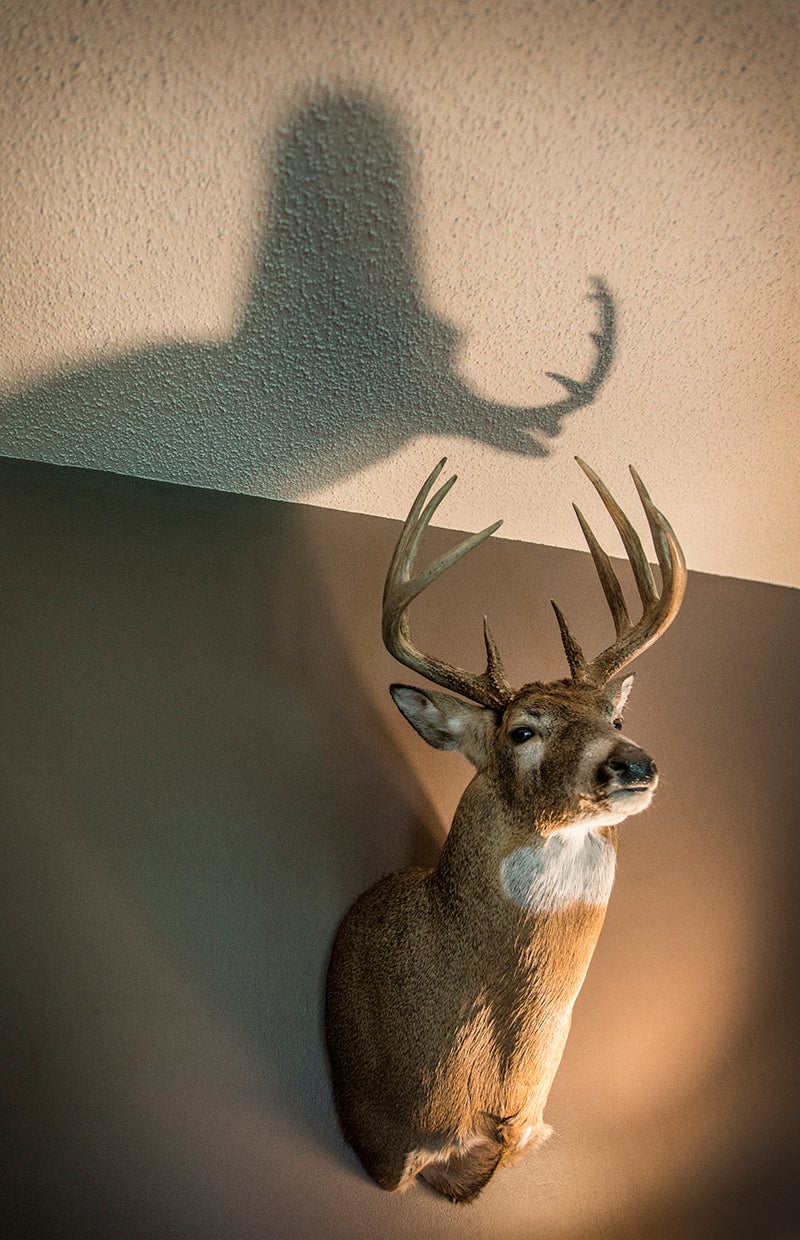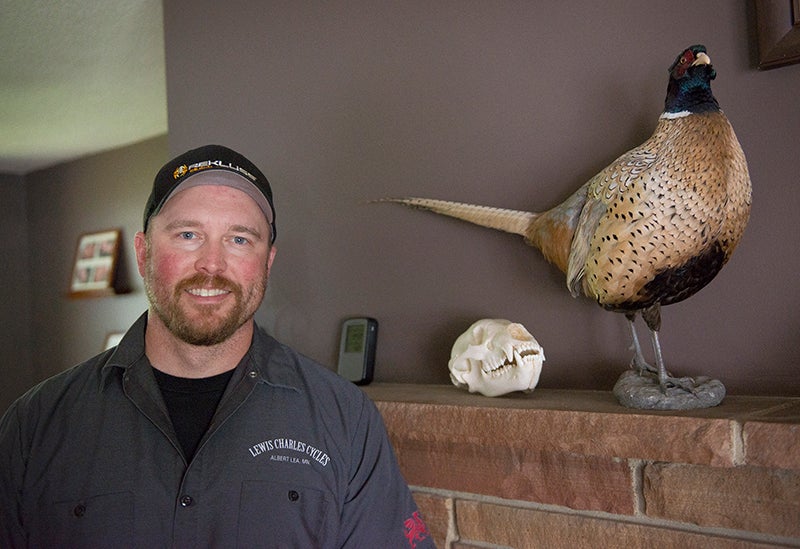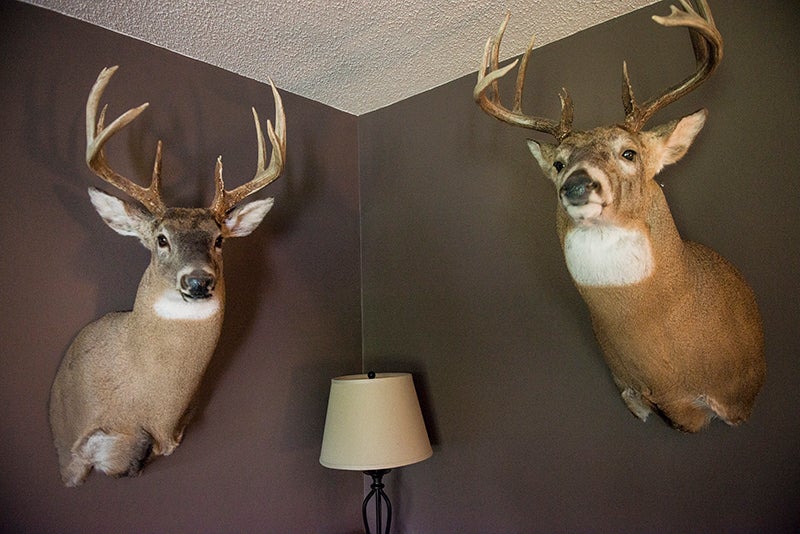For love of the outdoors
Published 11:22 pm Friday, October 5, 2018

- A deer trophy hangs on a wall inside Albert Lea resident Dusty Rafdal's home. Rafdal has been hunting deer during firearm and muzzleloader seasons for years. This is the first year he'll attempt bowhunting. - Colleen Harrison/Albert Lea Tribune
Hunting is a part of Minnesota and Albert Lea heritage
For everything there is a season. Especially when it comes to hunting.
There are currently 12 different hunting seasons underway in Minnesota — bear, morning dove, crow and deer (archery), to name a few.
According to Minnesota Department of Natural Resources Information Officer Dan Ruiter, hunting is a “big business” in Minnesota, even more so than the rest of the country. According to the most recent National Survey of Fishing, Hunting and Wildlife-Associated Recreation report, Minnesota participation in hunting is at 11 percent, compared to the 6 percent national average.
“It’s a big part of our heritage in Minnesota,” Ruiter said.
For many, hunting is a family tradition passed down between generations. This rings true for Albert Lea resident Dusty Rafdal, especially.
Rafdal, now 38, was around 1 year old when he went on his first hunt with his father, Steve.
“(My dad) said he wrapped me up in a blanket and took me out on a duck boat,” Dusty Rafdal said.
From there, Rafdal grew up hunting duck and pheasant with his dad, and the two still make a yearly trip to South Dakota to go pheasant hunting, and frequently go fishing together as well. Rafdal now hunts with his own children, and has been hunting with his now 14-year-old-son since he was 4 or 5.
When Rafdal started dating his wife years ago, he started deer hunting around the same time. Her family has a farm in the Owatonna area where they still continue to hunt. While he has always hunted deer during firearm or muzzleloader season, Rafdal said he will try bowhunting deer for the first time this year. In the past he has enjoyed muzzleloading season more than firearm, as it usually means less people are out on public land.

Dusty Rafdal, pictured with one of his pheasant trophies and a bear skull, has been hunting since he was a child. – Colleen Harrison/Albert Lea Tribune
He has gone bear hunting before, successfully bringing back three black bears over the years from northern Minnesota; and has gone elk hunting, but without bagging anything. He hopes to make a yearly elk hunt out west a new tradition, and said Alaska is definitely a hunting “bucket list” destination for game such as moose and bear.
Rafdal said he and his sons enjoy eating wild game they’ve caught, such as deer and bear, but his wife isn’t as much of a fan. Their home has a number of deer and pheasant trophies adorning the walls and mantle, along with a bear skull on display.
For those interested in hunting, but who haven’t grown up with it, Rafdal said there are a lot of opportunities to pick it up. He said more people go hunting than some realize, and those interested should ask their family, friends and neighbors. There’s plenty of public land that can be used, he said.
“It’s a great past time to do with your family,” Rafdal said. “Once you start, it’s pretty addicting.”
Rafdal also recommended that those who aren’t familiar with hunting make sure they know the rules and regulations, as they can often change from year to year.
Of course, safety should always be paramount when hunting as well.
“Know your surroundings,” Rafdal said.
“Know what your target is and what’s beyond your target,” Ruiter said. “Treat every firearm as if it’s loaded.”
Ruiter added that while anyone born after 1979 is required to have firearm safety certification when hunting, he encourages everyone to have that certificate.
Weather should always be factored in as well, Ruiter said. Damp or cool conditions can lead to hypothermia faster than most realize. He said it’s important for hunters to keep not only themselves safe, but those in their surroundings as well. People also need to use caution when climbing, as he said the highest number of injuries on hunting trips are due to people falling from deer stands.
There are plenty of resources available through the DNR, Ruiter said, such as classes, tips and other information. He added that there are types of species, especially small game, that can be hunted without breaking the bank.
“(Hunting) can provide a lot of inexpensive entertainment or recreation,” he said.
For Rafdal, hunting is an escape from cellphones and other everyday distractions.
“I think it’s the love of the outdoors,” he said. “Getting out of your day-to-day life is relaxing.”
The things he has gotten to see and experience have made every trip worth it, Rafdal said — whether it’s seeing firsthand how much noise a porcupine makes tromping through the woods, or seeing pheasants come out of roosting in the morning.
“There’s a lot of neat stuff you see out there that you’d miss out on,” he said. “Just seeing nature wake up is a pretty neat thing.”
Minnesota hunting seasons
Bear: Sept. 1-Oct. 14
Deer (archery): Sept. 15-Dec. 31
Turkey: Sept. 29-Oct. 28
Pheasant: Oct. 13-Jan. 1
Deer (firearm): Nov. 3-Nov. 25 (depending on zone)
Deer (muzzleloader): Nov. 24-Dec. 9
Check Minnesota DNR’s site for a full list of seasons and more info

Deer trophies hang inside Albert Lea resident Dusty Rafdal’s home. Rafdal has been hunting deer during firearm and muzzleloader seasons for years. This is the first year he’ll attempt bowhunting. – Colleen Harrison/Albert Lea Tribune




